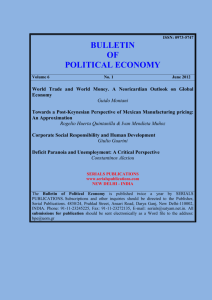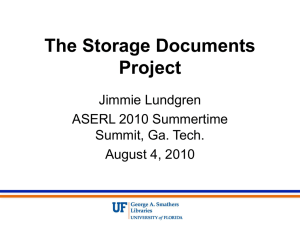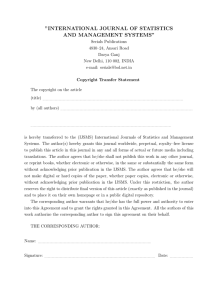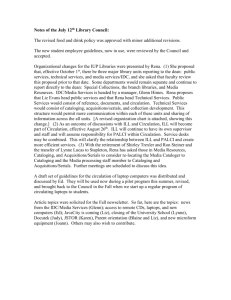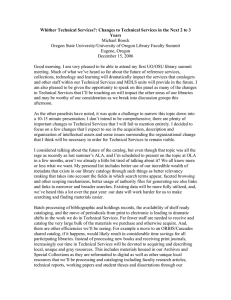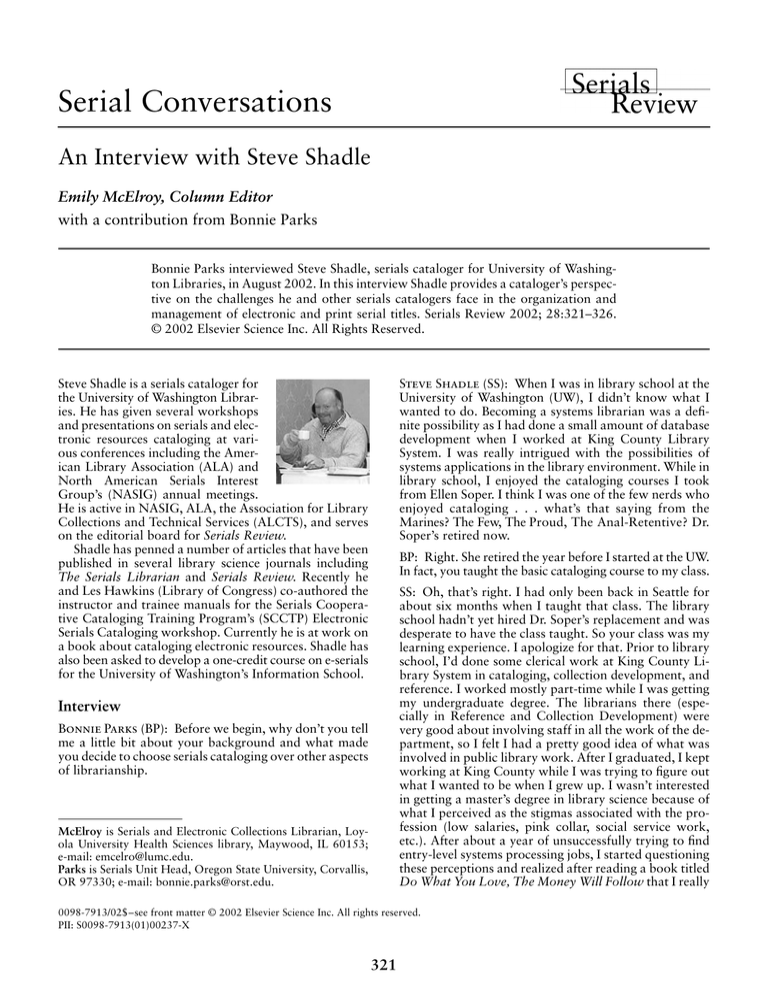
Serial Conversations
An Interview with Steve Shadle
Emily McElroy, Column Editor
with a contribution from Bonnie Parks
Bonnie Parks interviewed Steve Shadle, serials cataloger for University of Washington Libraries, in August 2002. In this interview Shadle provides a cataloger’s perspective on the challenges he and other serials catalogers face in the organization and
management of electronic and print serial titles. Serials Review 2002; 28:321–326.
© 2002 Elsevier Science Inc. All Rights Reserved.
Steve Shadle is a serials cataloger for
the University of Washington Libraries. He has given several workshops
and presentations on serials and electronic resources cataloging at various conferences including the American Library Association (ALA) and
North American Serials Interest
Group’s (NASIG) annual meetings.
He is active in NASIG, ALA, the Association for Library
Collections and Technical Services (ALCTS), and serves
on the editorial board for Serials Review.
Shadle has penned a number of articles that have been
published in several library science journals including
The Serials Librarian and Serials Review. Recently he
and Les Hawkins (Library of Congress) co-authored the
instructor and trainee manuals for the Serials Cooperative Cataloging Training Program’s (SCCTP) Electronic
Serials Cataloging workshop. Currently he is at work on
a book about cataloging electronic resources. Shadle has
also been asked to develop a one-credit course on e-serials
for the University of Washington’s Information School.
Steve Shadle (SS): When I was in library school at the
University of Washington (UW), I didn’t know what I
wanted to do. Becoming a systems librarian was a definite possibility as I had done a small amount of database
development when I worked at King County Library
System. I was really intrigued with the possibilities of
systems applications in the library environment. While in
library school, I enjoyed the cataloging courses I took
from Ellen Soper. I think I was one of the few nerds who
enjoyed cataloging . . . what’s that saying from the
Marines? The Few, The Proud, The Anal-Retentive? Dr.
Soper’s retired now.
BP: Right. She retired the year before I started at the UW.
In fact, you taught the basic cataloging course to my class.
SS: Oh, that’s right. I had only been back in Seattle for
about six months when I taught that class. The library
school hadn’t yet hired Dr. Soper’s replacement and was
desperate to have the class taught. So your class was my
learning experience. I apologize for that. Prior to library
school, I’d done some clerical work at King County Library System in cataloging, collection development, and
reference. I worked mostly part-time while I was getting
my undergraduate degree. The librarians there (especially in Reference and Collection Development) were
very good about involving staff in all the work of the department, so I felt I had a pretty good idea of what was
involved in public library work. After I graduated, I kept
working at King County while I was trying to figure out
what I wanted to be when I grew up. I wasn’t interested
in getting a master’s degree in library science because of
what I perceived as the stigmas associated with the profession (low salaries, pink collar, social service work,
etc.). After about a year of unsuccessfully trying to find
entry-level systems processing jobs, I started questioning
these perceptions and realized after reading a book titled
Do What You Love, The Money Will Follow that I really
Interview
Bonnie Parks (BP): Before we begin, why don’t you tell
me a little bit about your background and what made
you decide to choose serials cataloging over other aspects
of librarianship.
McElroy is Serials and Electronic Collections Librarian, Loyola University Health Sciences library, Maywood, IL 60153;
e-mail: emcelro@lumc.edu.
Parks is Serials Unit Head, Oregon State University, Corvallis,
OR 97330; e-mail: bonnie.parks@orst.edu.
0098-7913/02$–see front matter © 2002 Elsevier Science Inc. All rights reserved.
PII: S0098-7913(01)00237-X
321
Parks / Serials Review 28/4 (2002) 321–326
should consider going to library school.1 I was also struggling with coming out of the closet about the same time
and making the decision to accept my sexuality. Accepting
my career choice went hand-in-hand in a weird sort of way
(my coming out as a librarian as it were). This connection
was only reinforced by the fact that my first ALA conference was in San Francisco during Pride weekend.
My first job out of library school was at the U.S.
Agency for International Development (USAID) in Washington, D.C., where I was a technical services librarian. It
was a small federal agency library employing three librarians and three technicians. We didn’t do extensive
research, only quick reference. There was a separate research staff to do in-depth analysis. It was a good learning
experience since I was doing a variety of things and the
subject matter was interdisciplinary because of the varied
nature of foreign assistance projects. I was always learning new things. Because I was working for a contractor,
the pay and stability weren’t great. Eventually I realized
that I wasn’t cut out to work in a special library. When
I was in library school, I had interviewed for an internship at the Library of Congress (LC). I saw the opportunities at that library and what kind of institution it was.
When I was hired at USAID, I had it in the back of my
head that I still wanted to work at LC. When I decided to
leave USAID, I started applying for any positions at LC
that I was more or less qualified for. The first position I
was offered was an ISSN cataloger at the National Serials
Data Program (NSDP).2 It was only after I was trained at
NSDP that I really discovered how interesting serials cataloging was. I was being trained right at the time that the
CONSER Cataloging Manual was being developed, so
Pamela Simpson, another recent NSDP hire, and myself
were guinea pigs for the manual.3 At LC, I really discovered how interesting serials cataloging was.
Library of Congress. NSDP cataloged it all, everything
from Hustler Busty Beauties to academic journals to
grange newsletters to popular magazines. I even helped
catalog a serial t-shirt: each issue had a short story
printed on it. Like all serials, it changed its title—from
Tee Shorts to The Cotton Quarterly.
It was in NSDP that I also started cataloging computer
files. At that point, it was mostly diskettes, but by the
time I left in early 1995 there were enough e-serials being
published that there was talk of establishing conventional
practices beyond what little was specified in AACR.
BP: So you didn’t have any serials experience when you
took the job?
SS: No, I didn’t have any serials experience other than
serials acquisitions when I was at USAID. Ellen Soper
taught a serials class at UW that I hadn’t taken. Serials
were not on my radar when I was in library school. If
someone had told me in library school that I would end
up as a serials cataloger, I’d be rolling on the floor. I’m not
sure what Julia Blixrud and Regina Reynolds saw in my
interview, but apparently they liked something since they
hired me. I think the reason they feel comfortable hiring
people without serials experience is that the training at
NSDP is very thorough. What’s most important to them
is that they hire people who will be good catalogers.
NSDP quickly provides them with serials experience.
NSDP is sort of a cataloging boot camp in some ways.
You’re always thinking about production because a lot
of those publishers want their ISSN yesterday and you’ve
got this wide variety of serials to catalog and everything
you do is reviewed for at least six months, if not a year.
I had many conversations with my reviser (thank you,
Les Hawkins, for your patience), and it was in those conversations that I really began to understand what aspects
of serials cataloging came from the rules and what was
cataloger’s judgment.
BP: What was it that you found interesting about serials
cataloging?
BP: And now you’re a serials cataloger at the UW. Why
an academic library?
SS: I think the reasons I prefer cataloging serials to
monographs is the variety of materials and presentations
and the amount of judgment that is required. As Pamela
Simpson once told me, cataloging a serial is like studying
a gazelle as it bounds across the savannah; cataloging a
monograph is like doing an autopsy. I used this analogy
once at a basic serials cataloging workshop, and I’ll never
use it again. I think I alienated a few people. First, serials
tend to have non-standard presentations so there’s judgment involved there. And then because of their changing
nature, there’s more judgment involved in terms of describing how a serial changes. Oftentimes, you have to
guess what a serial might do in the future based on the
facts in hand and these days an e-mail to the publisher.
Identifying relationships between the title in your hand
and other serial titles adds another aspect to the work. I
feel especially fortunate to have been trained at NSDP
because of the variety of serials one catalogs there. Every
serial title published in the United States that is assigned
an ISSN is cataloged by NSDP. The variety of materials
I saw on a daily basis was greater than anything that
would be held in one individual library, including the
SS: Serials cataloging in a large, academic library was a
natural progression from ISSN cataloging. At the time I
left NSDP, ISSN catalogers only did original descriptive
cataloging. If they were working with copy, they would
verify subject headings, but they wouldn’t assign subject
headings or do authority work. When you’re expected to
assign an average of two ISSN an hour, you don’t have
time for the niceties of subject headings. Besides, NSDP’s
work really isn’t that of a library. NSDP is part of an international serials registration system assigning ISSN as
a standard identifier. I understand that NSDP catalogers
are now actually cataloging for the Library of Congress
collection and are doing full-level cataloging. Cataloging
for a large academic library was a natural next step in my
career.
BP: What are some of the biggest challenges you encounter when cataloging serial titles?
SS: I think the most challenging thing really is electronic
serials, not only in terms of cataloging, but also in terms
322
Parks / Serials Review 28/4 (2002) 321–326
of resource and collection management. I think the most
common cataloging challenge is that there are no standard presentations of bibliographic information. Often
within a particular package or aggregation you might
have a standard way of presenting information, so that if
you are actually creating records for an entire package,
after you’ve done the first few, then the rest of them are
like, “I know where to get this information.” But across
the board there are so few standards.
Cataloging serials generally is difficult because the
presentations are inconsistent, but they are even more so
with e-serials. It’s also more difficult to navigate an electronic serial. With a print serial you can flip through the
pages to find the information you need. With an e-serial,
you have to click, click, click everywhere to find the information necessary for cataloging. I think, in that respect, it’s a little more challenging and a lot more time
consuming. Also, and I say this a lot in workshops, one
of the problems we have that really hasn’t been dealt with
very well in terms of the Anglo American Cataloguing
Rules (AACR2) Chapter 12 changes is the fact that with
tangible serials (print serials or any other tangible formats) each issue has to self-identify for the whole system
to work. In order for the publishers to know what they’re
sending out, in order for the receipt staff to know what
they’re receiving, in order for the acquisitions staff to
know what they’ve ordered and need to claim, in order
for a user to find a citation, and in order for the binding
people to know what they have, every issue needs to selfidentify. So you’re going to have some kind of a chief
source that the cataloger can use on every issue. Well,
you don’t have to do that in the electronic world. In the
electronic world, what people care about is the article,
the content. It’s like the publisher has cut out the articles
of all of the issues and they’ve put them in one place on
the Web space, and then they’ve taken one copy of the
cover, masthead and the editorial information and
they’ve put that in another place on the Web space, so
what happens is that we can’t as easily rely on the issue
to identify the bibliographic information that is used for
identification and description. In successive entry cataloging we have to rely on individual issues because we
compare from issue to issue to issue to identify where a
title change or a major change happens. If the information is no longer on each issue, this absence really presents
a challenge. Another challenge is the link maintenance
issue—the location (URL) of the resource changes.
signed to resources currently cataloged as monographs,
but our e-resource catalogers have been so busy that they
haven’t had time to do more than read up on the project.
We haven’t assigned PURLs for more e-serials because
we’ve been spending our copious spare time on figuring
out how to incorporate Serials Solutions data into our
workflows and how to integrate that with Innovative Interfaces’ new WebBridge and e-serials holdings software.
We haven’t had a lot of new non-commercial titles to catalog recently and I haven’t had the time to retrospectively
identify e-serials that can use PURLs.
BP: Who else was involved in the pilot project and how
does it work?
SS: University of California at Los Angeles (UCLA) was
the primary contributor of PURLs (nearly 900 of 2047).
Valerie Bross at UCLA has done an absolutely fantastic
job of managing the project. The process isn’t difficult. It
is basically a two-step process of searching the PURL database to confirm your URL hasn’t already been assigned
a PURL, then filling out a simple form to assign a PURL
for that URL. Until PURLs can be automatically generated from an OCLC Passport or Connexion session, it is
an extra step in the process (one which I think is well
worth the benefit). For the thirty-four PURLs we’re responsible for, maintenance has been minor, only one or
two titles at most on the weekly link maintenance report.
More information about the project is available from the
CONSER home page.4
BP: This sounds similar to the process used by the Government Printing Office (GPO).
SS: It’s exactly what GPO is doing; only the records are
directly maintained by a single organization like GPO.
Because GPO has a mandate for cataloging U.S. government publications, it makes sense for them to be responsible for that area of the world. And in some respects it
probably makes sense for CONSER to be responsible for
maintaining e-serial access since there is an organizational commitment to describe and provide access to serials. As you know, the scope of the CONSER PURL Pilot
is freely-available e-serials which are not U.S. government
publications. The GPO PURL server controls U.S. government publications.
BP: But it sounds like a project with a great deal of potential, especially in a cooperative environment.
BP: That’s a problem faced by anyone who catalogs Web
resources. I understand you’re involved in a CONSER
project involving the use of PURLs (Persistent Uniform
Resource Locators) to assist in maintaining links for
freely-available e-serials.
SS: I definitely believe that a cooperative PURL maintenance program is one effective solution as long as the
database is large enough to be seen as a useful resource,
for example, one with the Program for Cooperative Cataloging (PCC). Because PURLs are becoming more commonplace, I’ve seen a number of institutional-based PURL
servers, which in some respects defeats the purpose of
having a PURL server. Unless there is some coordination
between PURL servers or perhaps some very clear, commonly acknowledged scopes among PURL servers (i.e.,
GPO covers U.S. governmental publications), it seems
like there is the potential for redundancy among PURL
servers.
SS: Right, the CONSER PURL Pilot. Funny you should
focus on the PURL project. Our contribution has been
pretty minimal. We’ve only contributed forty-six PURLs
to date. So to make up for it, we’ve hosted the project discussion list. It is my little contribution, plus it was a good
learning experience. Stephanie Sheppard, another serials
librarian at the UW, and I are the only catalogers who are
assigning PURLs here at the UW. PURLs can also be as-
323
Parks / Serials Review 28/4 (2002) 321–326
If you’re going to have a PURL project that a lot of
people are going to take advantage of, it’s got to be cooperative, it’s got to be opened up. Like with the success
of OCLC, if you do have people who are willing to
contribute and maintain, there is some real potential. I
still don’t think it’s a final solution because you still have
to have a person find out that a link is broken and maintain it. However, instead of being maintained in thousands of library catalogs and Web pages around the
world, it’s only maintained in one place. There’s a lot of
savings there, but it still requires a person to go in and
identify that the link is broken.
this data in conjunction with Innovative Interfaces’ WebBridge software to provide additional library services.
BP: What convinced you to give a commercial product,
in this case Serials Solutions, a try?
SS: In our case, it was a need to improve user service by
providing better, more customized access to our full-text
collections. Our systems office had discussed developing
link management software in-house, but with the number of packages and publishers we get full text from, the
problem was unmanageable. Now that OpenURL is becoming a more commonly used standard, we decided to
try Innovative Interfaces’ WebBridge software so that we
would have a compatible commercial product (and a single data store) to support some of these services. As I
mentioned, the specific data we were looking for to support the link management software was holdings data
and MARC records for the aggregator databases.
BP: So is CONSER considering designating someone as
a link maintainer?
SS: In the CONSER project, the institution that makes
the original PURL assignment is responsible for maintaining the PURL in the resolution table. OCLC runs link
validation software on a weekly basis. The institutional
coordinator then gets weekly error reports showing not
just 404 errors, but a number of conditions, including the
number of redirects. So if the original URL is now a
redirect, you get notified. The final report available
through the CONSER home page gives a good idea of the
scope in terms of the number of PURLs needing maintenance and other statistics.
BP: By now we’ve all heard about the upcoming AACR2
revisions, specifically those involving Chapter 12, the
chapter that deals with serials. What are some of these revisions, and how do they address some of the cataloging
challenges that you mentioned earlier?
SS: The main revision is the change of scope of Chapter
12 to “Continuing Resources” which now includes not
only serials but also a new type of material called “Integrating Resources.” These are defined as resources that
are added to or changed by updates that do not remain
discrete and are integrated into the resource. Websites,
loose-leaf publications, and databases are examples of
integrating resources. Until now, there were supplementary rule sets, like Adele Hallam’s guidelines for print
loose-leafs.5 Nancy Olson’s manual never really addressed describing how an electronic resource changed
over time.6 I think one of the great things about the
Chapter 12 revision is that catalogers will be able to describe consistently how a Website or a database changes
over time.
Other significant revisions that affect serials catalogers are the changes to the title change rules. Instead of referring to “title changes,” catalogers will be referring to
“major changes” and “minor changes.” This is the terminology used by the ISSN network to identify whether
a change is significant enough to create a new record,
thus a major change. Serials catalogers have previously
called any change significant enough to create a new
record a “title change” even if the change was not in the
title, but in the corporate body main entry. Then there are
many title changes that aren’t significant enough to be a
“title change” but are considered title variants. No wonder non-catalogers find serials cataloging so confusing.
I’m hopeful that the change in terminology will make our
conversations a little clearer. In addition to the terminology, the actual title change rules have changed significantly so that many fewer changes in the title will be considered major changes and so fewer successive entry
serial records will be created in the future.
To tell you the truth, I’m not sure that the change in
rules will help with the cataloging challenges I talked
about earlier. We’ll still have inconsistent and ambiguous
BP: You mentioned earlier that the serials department at
UW is looking into ways to incorporate Serials Solutions
data into the workflow. Many libraries are struggling
with ways to integrate e-journals and aggregators into
their OPACs, and many are coming up with homegrown
programs. Did you consider creating something locally?
SS: We’ve already created something locally in that
we’ve integrated e-journals and aggregators into our
WebPAC, more or less successfully. Links for titles in
smaller packages (usually less than a couple hundred) are
entered and maintained by our serials acquisition staff.
Catalog records for the individual titles from our two
largest aggregations (ProQuest and LexisNexis) are obtained from a third party and periodically machineloaded. We’ve also created an SQL database of catalog
records for all our electronic resources. This database,
called the Digital Registry, is spun off from our MARC
database on a daily basis and forms the basis for many of
our Web-based services, including the e-journals and
database pages and many of our subject-based pages.
The service that we’re not currently providing is a link
management service that takes OpenURL data (mostly
from our bibliographic databases) and returns library
services to the user (i.e., a list of services such as “Fulltext from ScienceDirect,” “Catalog search for this title,”
“ILL request”). In order to do article-level linking using
OpenURL, we need to have holdings data in a formatted
form for our e-serials, something we haven’t tracked to
date. Serials Solutions will be providing us with two sets
of data: holdings data for as many packages as we can get
from them, and full MARC records for titles from three
aggregator databases, ProQuest, LexisNexis and Expanded Academic Index. We’re then planning on using
324
Parks / Serials Review 28/4 (2002) 321–326
SS: We had twelve people, and it worked really well.
The evaluations were very positive. The course is very
information-dense. There’s some information about different approaches to providing access to aggregations
through the library catalog and also how to provide access
outside the catalog. There’s a little tutorial on OpenURL
using an SFX example because that was the only widely
available commercial product six months ago. I’m hopeful that it will get people who have never had to deal with
these issues before pointed in the right direction. And
there’s a bibliography where they can find out more
about various e-serial products and projects.
presentation of bibliographic information on electronic
resources, and catalogers will still have to use a lot of
judgment in creating original records for electronic serials. There are some e-serial specific guidelines for title
changes that will definitely help in determining whether
a particular e-serial title change is major or minor. I think
the main benefits are that catalogers now have rules governing how to describe the changing aspects of non-serially
published resources and that we’ll see more consistent
cataloging.
BP: What kind of an impact, if any, do you see these
changes having on users?
BP: This is the workshop that you co-developed with Les
Hawkins from LC?
SS: Records will include a lot more dates (date viewed,
last update, etc.) so that a user will have a better sense of
how current a particular record is. Better access will also
be provided since earlier access points (earlier titles, authors, issuing bodies) will be retained in the catalog
records. For example, if an online database changes its
name, the earlier name will be retained in the record
(MARC field 247) so searchers will be able to find the
earlier title in the catalog.
SS: Right, with Les Hawkins. Jean Hirons had identified
a number of people who could be workshop developers
for either the e-serials course or the advanced serials
course, which was being developed at the same time. Because of my background, she felt it would be more appropriate for me to work on the e-serials course. I’m one
of probably a couple dozen “experts” in the field. It’s really kind of funny because these days I really have to try
to make time for cataloging e-serials because we don’t do
a whole lot of original cataloging of e-serials. Most of the
titles we get (and I think this is true for a lot of people)
are part of a package or are commercially published so
there’s cataloging copy in OCLC for most of our new
titles. I know that there are people like David Van Hoy
from MIT, Renette Davis from University of Chicago,
Naomi Young from University of Florida, Becky Culbertson from University of California at San Diego, and
Valerie Bross (UCLA) who do a lot more cataloging and
are really much more the experts on this stuff than I am.
I just happened to be the one to write a couple of articles
and get involved with the training issues, so my name is
out there more.
BP: What about the impact on catalogers and serials
staff? I imagine there are some retraining issues that need
to be addressed.
SS: Not only retraining issues, but also some organizational issues. Since databases, Websites and loose-leafs
are cataloged using Chapter 12, who catalogs them?
Where do the divisional or personnel lines go? I might be
wrong on this, but I think the e-resources cataloging
community, as a whole, was not really aware of the extent of the changes to Chapter 12, and there might be a
small amount of panic out there when individual catalogers start seeing catalog records that include notes and
tagging conventions that are different from what they’re
used to seeing. These changes won’t affect all e-resources.
Static resources (individual documents, monographs)
will still be cataloged using Chapter 9. When the resource changes somehow, the cataloger will then need to
consult Chapter 12 in addition to Chapter 9.
SCCTP and the PCC are developing a one-day workshop on cataloging integrating resources. I understand
that the release date will be sometime in April 2003. In
the meantime, various organizations will be sponsoring
programs on the rule changes. ALCTS will be holding a
series of institutes on the revisions, and Jean Hirons’(LC)
overview of the changes is available from the CONSER
home page. My advice to electronic resource catalogers
is to keep your ears open for any continuing education
opportunities that might be available and take a look at
Jean’s overview to get an idea of what to expect.
BP: I understand that the course is aimed at those who
have serials cataloging experience.
SS: Yes. The course is geared towards people who have
serials cataloging experience but not necessarily a lot of
experience with e-serials. I really like the fact that it
doesn’t just focus on creating original records, but it also
addresses other, related issues.
BP: What are some of these common issues?
SS: Some of the issues covered include how to provide
access both within and without the catalog, how to handle a variety of change situations such as title, URL, or
format changes, and what is a serial versus an integrating
resource.
BP: Let’s talk a little more about the e-serials course with
which you’re currently involved.7
BP: A final question for you. As online resources become
more commonplace in libraries, how do you see the role
of serials catalogers evolving to meet the future challenges these resources present?
SS: The e-serials course was released in April 2002, and
I think that four workshops have been given since its release. I just gave it for the first time a couple of days ago
at OCLC Western Service Center in Lacey, Washington.
SS: Geez, you save the easy questions for the end! As we
use more commercial tools and products, I think serials
catalogers might become the “serial metadata experts,”
BP: How was the workshop received?
325
Parks / Serials Review 28/4 (2002) 321–326
being part of a team that manages serial data that can
come from a variety of sources or that is used in a variety
of services. It all depends on the library. At our institution, we’ve definitely seen a decrease in print serial workflow that is as much due to serials cancellation projects as
to the format. Or put another way, it’s cheaper for us to
buy a title in electronic form as part of a package than individually in print, so we’ll cancel the print. However, we
have a pretty sizable microfilm backlog, so I think someone will still be creating serial catalog records at the University of Washington for quite awhile.
2. National Serials Data Program. http://www.loc.gov/issn (17 August
2002).
Notes
7. Serials Cooperative Cataloging Training Program (SCCTP). The
materials for the SCCTP e-serials workshop have been translated into
Chinese and Spanish. More information about the course is available
at http://www.loc.gov/acq/conser/scctp/home.html (19 August 2002).
3. CONSER Cataloging Manual (CCM). Washington, DC: Serial
Record Division, Library of Congress, distributed by the Cataloging
Distribution Service, 1998.
4. CONSER PURL Pilot. http://www.loc.gov/acq/conser/purl/
documentation.htm (17 August 2002).
5. Adele Hallam, Cataloging Rules for the Description of Looseleaf
Publications with Special Emphasis on Legal Materials, 2nd ed. Washington, DC: Library of Congress, 1989.
6. Nancy B. Olson, Cataloging Internet Resources: A Manual and
Practical Guide, 2nd ed. Dublin, OH: OCLC, 1997.
1. Marcia Sinetar, Do What You Love, the Money Will Follow: Discovering Your Right Livelihood. New York: Paulist Press, 1987.
326

